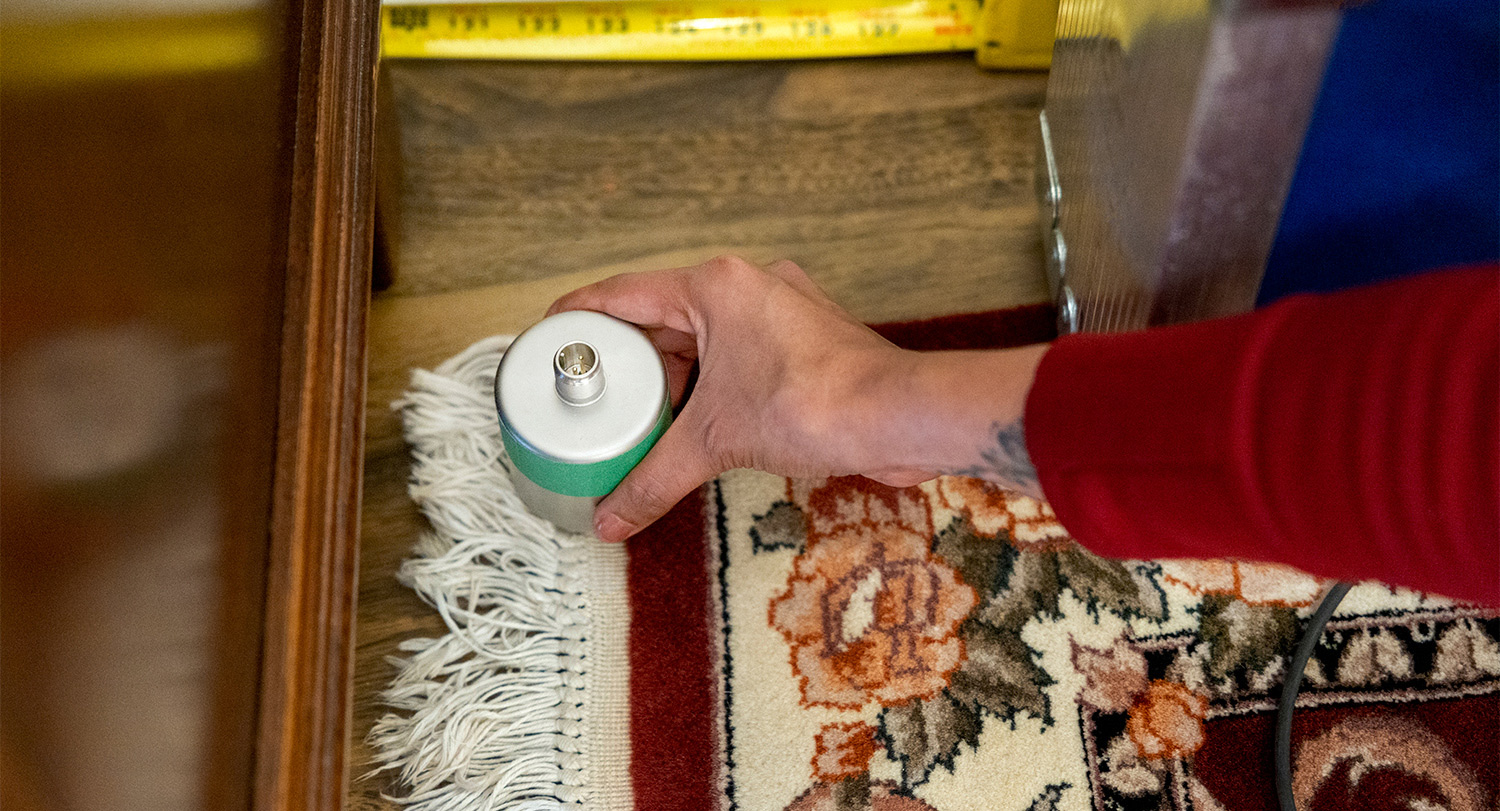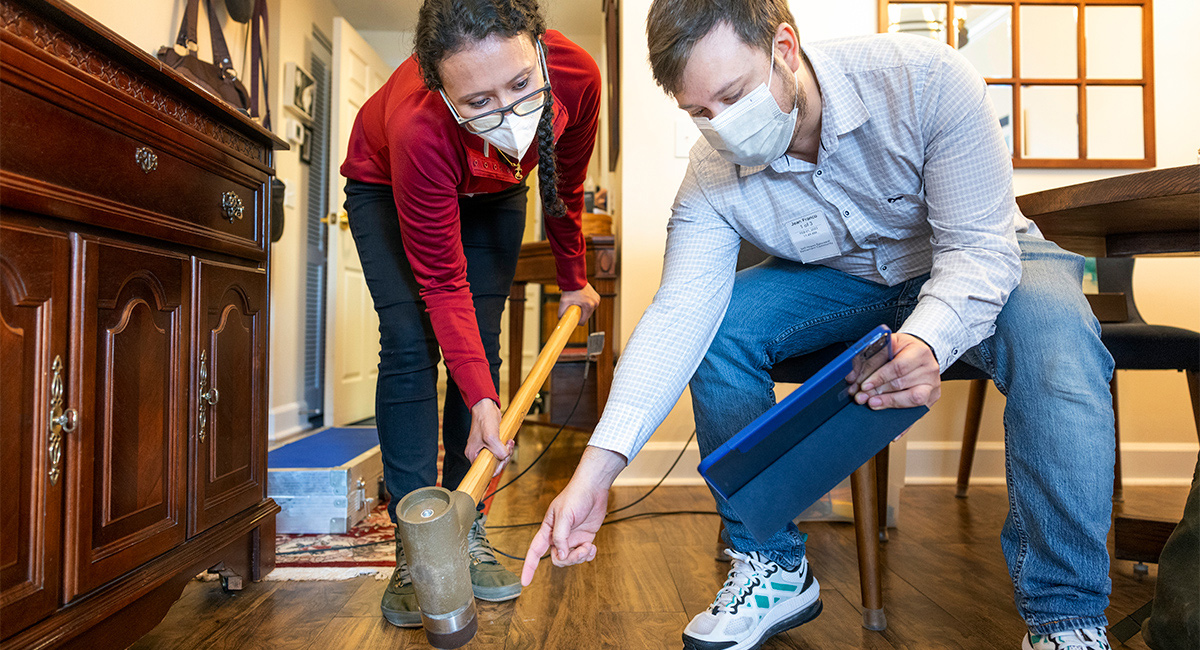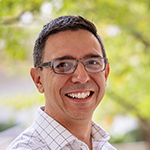
Hidden behind the furniture and along the baseboards of Shirley Kuiper’s apartment are small sensors that record every step she takes in her home at the Still Hopes retirement community in West Columbia.
The unobtrusive sensors, along with a tucked-away laptop, measure each vibration of the floor and send that information back to University of South Carolina researchers, who are studying ways to track a person’s gait and walking speed.
The research at Still Hopes and in the university’s civil engineering lab is part of a collaboration between professors in the College of Engineering and Computing and the Arnold School of Public Health. Using grants from the National Institute on Aging, civil and environmental engineering professor Juan Caicedo and his team have developed the technology that can capture details about a person’s gait from the vibrations their feet make on floor. Meanwhile exercise science professor Stacy Fritz is able to take that information and extrapolate what the variations in a person’s walking speed and step length can say about health changes and challenges.
That information is important because walking speed is referred to by some as the sixth vital sign, meaning it is one of the key elements in determining a person’s overall health and well-being. When a person’s steps slow, family members or medical professionals can be warned about a possible problem brewing, and the information about walking speed could also aid in the ability of older people to age comfortably at home.
“This started with a goal of needing to connect health professionals with patient’s performance. If you think about a vital sign, you often think about something like blood pressure, which tells you about the underlying functional and physiological changes that may be going on. It can say, ‘Hey, something’s off. We need to look further into it and figure out what's going on.’ Walking speed is kind of the same thing. ‘Hey, something's going wrong here, the body is slowing down. Let's try to figure out what the reason is for that,’ ” Fritz says.

The research begins with Caicedo and his team, who originally started working on the idea of floor vibrations to develop a way to identify when people fall. Other ways to detect falls, including watches and pendants, are not always the best option for older people, who have to remember to wear or charge them.
Along with USC’s engineering and public health departments, the project is a collaboration with San Francisco State University, and the group also has a long-standing collaboration with Dr. Victor Hirth, a geriatric medical specialist in Columbia.
The work has expanded to capture people’s gait, developing the fundamental science that can enable the measurements of walking speed in people’s homes without cameras or wearable devices.
“If your gait is changing, that’s not a good sign long term. If your walking speed gets too slow, that statistically shows that you might have a good chance of falling in the near future,” Caicedo says. “So, the idea is we would go into people’s actual homes, where they are living independently, and take measurements.”
The sensors are the same types that have been used for decades to record earthquakes, but these extremely sensitive versions can capture minor levels of vibration, such as a footstep.
At Kuiper’s apartment at Still Hopes, engineering research assistant professor Yohanna Mejia Cruz and Garrett Hainline, a Ph.D candidate in exercise science, place sensors under furniture and in places where residents won’t trip or get injured. Then a hammer is used to hit the floor and see how it reacts to impact. A computer model is created to calculate what happens to the floor on each impact, showing the vibrations made as a person walks around the home.
Next comes the detailed work of interpreting the information coming from those sensors, Caicedo says.
“Yohanna (Mejia Cruz) is an expert in probabilistic methods. When we were putting the team together, that’s something we really needed. Behind the scenes, there is some very high-level probability work that is happening to be able to produce those numbers,” he says.
Once the numbers are run, the information makes its way to the health researchers.
“I think the most amazing part of this partnership of engineering and public health working together is the fact that we have very different skillsets,” Fritz says. “There's no way I could do this work without the engineers to figure out how to analyze and how to understand the information. And then I'm kind of the meaning side, working on the health focus. So that's the neat pairing that that comes from this grant.”

"Behind the scenes, there is some very high-level probability work that is happening to be able to produce those numbers."
Fritz has long studied walking speed as a guide to a person’s health, believing it is a reliable measure that offers the ability to predict myriad things that lead to health issues.
Slowed walking speed could be a sign of decreased range of motion, pain, cardiovascular events or decreased cognition, and alerts medical professionals of the need to look further, she says.
“Right now, when I measure walking speed as a physical therapist, it's with a stopwatch and a runway. But it's one measurement in time. We thought if we could sample this in someone's home we could get more insight,” Fritz says. “If we can continuously collect it and see a change over the years, we would be able to say, ‘Hey, look, Mom’s walking speeds declined this week. We really should go check.’”
The key is using the technology in a less intrusive way to document someone’s movement, and hopefully keep them safe and at home.
“Aging in place is a big deal. If people can stay safely in a home, they want to,” Fritz says. “And if you know that you’re being monitored, that can help.”
That ability to help is part of what drew Mejia Cruz to the project. As a civil engineer, she says she was used to collecting data on a structure, but this project allows her to have an impact on people’s health.
“I actually got interested because my mom has Parkinson's and I saw there was a lot of potential to actually contribute to this, even as a civil engineer,” she says.
Caicedo says the project shows that USC is developing an ecosystem where universities develop fundamental knowledge and then companies can take that knowledge, write the intellectual property and start developing products. That’s what has happened on this project with Caicedo and a former student.
Several years ago Caicedo worked with Benjamin Davis, who earned his undergraduate and doctoral degrees at USC, on ways to use the vibration of a physical structure to determine when someone fell. The work turned into a fellowship, and his Ph.D. dissertation turned into patent filings. After spending six years researching the automatic detection of falls through technology, Davis founded and serves as the CEO of Columbia-based ASSET, which creates intelligent infrastructure in physical spaces. He says his work tracking footsteps has fed his desire as an entrepreneur and inventor.
“I had an itch to invent things, to make a company that does good in the world and creates impactful technology that helps people out. I also have an enduring fascination with tech and making intelligent infrastructure that changes how people interact with the built environment,” Davis says.
This is the second time Kuiper, a retired USC business professor, has agreed to have researchers place sensors in her home.
“I just think any time somebody is trying to learn more about how the human body functions, what might be done to anticipate problems — it's just something I think is worth supporting in any way I can,” she says.